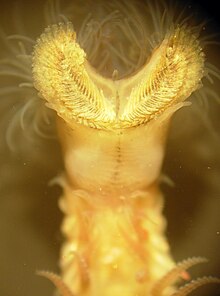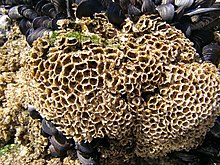51:
222:
38:
298:
present at low densities to dense hummocks and mounds where there is a high density. The tubes are built from shell fragments or sand and are used to protect the worm from predators and can be repaired if damaged near the entrance. The tube is made up of a number of overlapping layers of material glued together with mucus. There are two sexes and
247:. The tubes are arranged in close proximity and have a distinctive honeycomb-like appearance. These reefs range from 30 centimetres (12 in) to 2 metres (6.6 ft) thick and take the form of hummocks, sheets or more massive formations. Adult size ranges from 30 to 40 millimetres (1.2 to 1.6 in). The
302:
takes place in the spring and again in the autumn. The larvae develop in the water column and can detect the substance the adults use to bind their tubes and follow this to find a location to settle on. They are filter feeders and use cilia covered tentacles to extract food from the water. The reefs
297:
occurs on the bottom third or so of the intertidal zone and in the shallow subtidal zone. The worms construct different types of structures depending on the conditions. Where it occurs along rocky shorelines among bladderwrack then the agglomeration of tubes vary from thin encrustations if they are
331:
266:
is found in the
Mediterranean and the north Atlantic from Britain south to Morocco. In Britain and Ireland it is mainly found in inter-tidal zones along southern and western coasts from the
735:
774:
709:
748:
434:
800:
877:
578:
872:
696:
453:
839:
368:
171:
753:
761:
657:
527:
50:
779:
496:
315:
602:
323:
662:
255:
which is used to seal the tube opening. Depending on the local substrate, the colour of the tube varies.
252:
240:
151:
844:
683:
634:
356:
867:
831:
45:
740:
813:
670:
194:
639:
282:
lies at a depth of 12–30 metres (39–98 ft) and is the only known example of a sub-tidal
818:
475:
Marine Life
Information Network: Biology and Sensitivity Key Information Reviews, . Plymouth
221:
787:
327:
299:
95:
20:
574:
549:
198:
37:
861:
267:
209:
at its northern limit in the northeast
Atlantic. Its common name is derived from the
206:
167:
118:
675:
275:
826:
766:
722:
625:
466:
399:
190:
128:
108:
426:
318:
species. Published in 1994, the plan encouraged the mapping and surveying of
701:
279:
210:
62:
792:
649:
619:
271:
714:
243:
it constructs from cemented coarse sand and/or shell material, forming
236:
202:
82:
727:
248:
72:
596:
322:
reefs. It is also included in local
Biodiversity Action Plans e.g.
251:
has three pairs of flattened chaetal sheaths, its chaetes form an
220:
550:"Newry, Mourne and Down Local Biodiversity Action Plan 2017-2022"
805:
244:
688:
600:
575:"Habitats and species of principal importance in England"
465:
Jackson, A. (2008). Tyler-Walters H.; Hiscock K. (eds.).
213:-like pattern it creates when building its tube reefs.
477:. Marine Biological Association of the United Kingdom
609:
19:For the other animal called "honeycomb worm", see
355:Gérard Bellan (2011). Read G, Fauchald K (eds.).
338:reefs and provides a legal conservation mandate.
522:
520:
8:
286:reef off the coast of Britain and Ireland.
597:
36:
27:
555:. Newry, Mourne and Down District Council
393:
391:
389:
387:
385:
332:list of habitats of principal importance
303:that they build encourage biodiversity.
435:United Kingdom Biodiversity Action Plan
347:
420:
418:
7:
579:Joint Nature Conservation Committee
504:National Parks and Wildlife Service
497:"Wicklow Reef SAC - Site Synopsis"
401:Grzimek's Animal Life Encyclopedia
334:(priority habitats) which include
14:
369:World Register of Marine Species
49:
193:. It is distributed around the
1:
326:in Northern Ireland. In 2010
878:Taxa named by Carl Linnaeus
894:
205:. It is also found in the
18:
873:Animals described in 1767
365:World Polychaeta database
157:
150:
46:Scientific classification
44:
35:
30:
528:"Honeycomb Worm Biology"
316:Biodiversity Action Plan
16:Species of annelid worm
324:Newry, Mourne and Down
229:
185:, (also known as the
224:
197:, and from the north
189:), is a reef-forming
640:Sabellaria_alveolata
611:Sabellaria alveolata
530:. The REEHAB Project
469:Sabellaria alveolata
429:Sabellaria alveolata
359:Sabellaria alveolata
312:Sabellaria alveolata
295:Sabellaria alveolata
284:Sabellaria alveolata
264:Sabellaria alveolata
241:lives in small tubes
233:Sabellaria alveolata
227:Sabellaria alveolata
182:Sabellaria alveolata
161:Sabellaria alveolata
290:Habitat and ecology
239:(ringed worm) that
398:"Honeycomb worm".
230:
855:
854:
814:Open Tree of Life
603:Taxon identifiers
581:. 17 October 2019
427:"Action plan for
425:Moffat A (1999).
361:(Linnaeus, 1767)"
195:Mediterranean Sea
178:
177:
143:S. alveolata
885:
848:
847:
835:
834:
822:
821:
809:
808:
796:
795:
783:
782:
770:
769:
767:NBNSYS0000188452
757:
756:
744:
743:
731:
730:
718:
717:
705:
704:
692:
691:
679:
678:
666:
665:
653:
652:
643:
642:
630:
629:
628:
598:
591:
590:
588:
586:
571:
565:
564:
562:
560:
554:
546:
540:
539:
537:
535:
524:
515:
514:
512:
510:
501:
493:
487:
486:
484:
482:
462:
456:
451:
445:
444:
442:
441:
422:
413:
412:
410:
409:
395:
380:
379:
377:
375:
352:
163:
54:
53:
40:
28:
893:
892:
888:
887:
886:
884:
883:
882:
858:
857:
856:
851:
843:
838:
830:
825:
817:
812:
804:
799:
791:
788:Observation.org
786:
778:
773:
765:
760:
752:
747:
739:
734:
726:
721:
713:
708:
700:
695:
687:
682:
674:
669:
661:
656:
648:
646:
638:
633:
624:
623:
618:
605:
595:
594:
584:
582:
573:
572:
568:
558:
556:
552:
548:
547:
543:
533:
531:
526:
525:
518:
508:
506:
499:
495:
494:
490:
480:
478:
471:Honeycomb worm"
464:
463:
459:
452:
448:
439:
437:
424:
423:
416:
407:
405:
397:
396:
383:
373:
371:
354:
353:
349:
344:
328:Natural England
309:
292:
261:
219:
174:
165:
159:
146:
96:Pleistoannelida
48:
31:Honeycomb worm
24:
21:sandcastle worm
17:
12:
11:
5:
891:
889:
881:
880:
875:
870:
860:
859:
853:
852:
850:
849:
836:
823:
810:
797:
784:
771:
758:
745:
732:
719:
706:
693:
680:
667:
654:
644:
631:
615:
613:
607:
606:
601:
593:
592:
566:
541:
516:
488:
457:
446:
414:
381:
346:
345:
343:
340:
308:
305:
291:
288:
260:
257:
218:
215:
199:Atlantic Ocean
187:honeycomb worm
176:
175:
166:
155:
154:
148:
147:
140:
138:
134:
133:
126:
122:
121:
116:
112:
111:
106:
99:
98:
93:
86:
85:
80:
76:
75:
70:
66:
65:
60:
56:
55:
42:
41:
33:
32:
15:
13:
10:
9:
6:
4:
3:
2:
890:
879:
876:
874:
871:
869:
866:
865:
863:
846:
841:
837:
833:
828:
824:
820:
815:
811:
807:
802:
798:
794:
789:
785:
781:
776:
772:
768:
763:
759:
755:
750:
746:
742:
737:
733:
729:
724:
720:
716:
711:
707:
703:
698:
694:
690:
685:
681:
677:
672:
668:
664:
659:
655:
651:
645:
641:
636:
632:
627:
621:
617:
616:
614:
612:
608:
604:
599:
580:
576:
570:
567:
551:
545:
542:
529:
523:
521:
517:
505:
498:
492:
489:
476:
472:
470:
461:
458:
455:
450:
447:
436:
432:
430:
421:
419:
415:
403:
402:
394:
392:
390:
388:
386:
382:
370:
366:
362:
360:
351:
348:
341:
339:
337:
333:
329:
325:
321:
317:
313:
306:
304:
301:
296:
289:
287:
285:
281:
277:
273:
269:
268:Western Isles
265:
258:
256:
254:
250:
246:
242:
238:
234:
228:
225:The tubes of
223:
216:
214:
212:
208:
207:British Isles
204:
200:
196:
192:
188:
184:
183:
173:
169:
164:
162:
156:
153:
152:Binomial name
149:
145:
144:
139:
136:
135:
132:
131:
127:
124:
123:
120:
119:Sabellariidae
117:
114:
113:
110:
107:
104:
101:
100:
97:
94:
91:
88:
87:
84:
81:
78:
77:
74:
71:
68:
67:
64:
61:
58:
57:
52:
47:
43:
39:
34:
29:
26:
22:
610:
583:. Retrieved
569:
557:. Retrieved
544:
532:. Retrieved
507:. Retrieved
503:
491:
479:. Retrieved
474:
468:
460:
449:
438:. Retrieved
428:
406:. Retrieved
404:. Gale. 2003
400:
372:. Retrieved
364:
358:
350:
336:S. alveolata
335:
330:published a
320:S. alveolata
319:
311:
310:
307:Conservation
294:
293:
283:
276:Wicklow Reef
263:
262:
259:Distribution
232:
231:
226:
186:
181:
180:
179:
160:
158:
142:
141:
129:
102:
89:
25:
827:SeaLifeBase
723:iNaturalist
585:5 September
374:December 6,
217:Description
862:Categories
440:2009-08-05
408:2009-08-01
342:References
191:polychaete
130:Sabellaria
109:Sedentaria
868:Sabellida
454:Hermelles
280:Irish Sea
253:operculum
211:honeycomb
201:to south
137:Species:
69:Kingdom:
63:Eukaryota
741:10901881
647:BioLib:
626:Q1147658
620:Wikidata
559:25 March
534:25 March
314:is a UK
300:spawning
272:Cornwall
168:Linnaeus
115:Family:
83:Annelida
79:Phylum:
73:Animalia
59:Domain:
715:5199252
481:2 March
278:in the
237:annelid
203:Morocco
125:Genus:
845:130866
819:638886
806:130866
780:251482
728:338082
689:488974
663:362379
509:14 May
431:reefs"
274:. The
249:thorax
235:is an
840:WoRMS
832:40883
793:27594
754:67679
736:IRMNG
702:50866
697:EUNIS
676:4TV53
650:84000
553:(PDF)
500:(PDF)
245:reefs
103:Clade
90:Clade
801:OBIS
775:NCBI
749:ITIS
710:GBIF
658:BOLD
587:2021
561:2020
536:2020
511:2022
483:2020
376:2011
172:1767
762:NBN
684:EoL
671:CoL
635:ADW
270:to
864::
842::
829::
816::
803::
790::
777::
764::
751::
738::
725::
712::
699::
686::
673::
660::
637::
622::
577:.
519:^
502:.
473:.
433:.
417:^
384:^
367:.
363:.
170:,
105::
92::
589:.
563:.
538:.
513:.
485:.
467:"
443:.
411:.
378:.
357:"
23:.
Text is available under the Creative Commons Attribution-ShareAlike License. Additional terms may apply.

